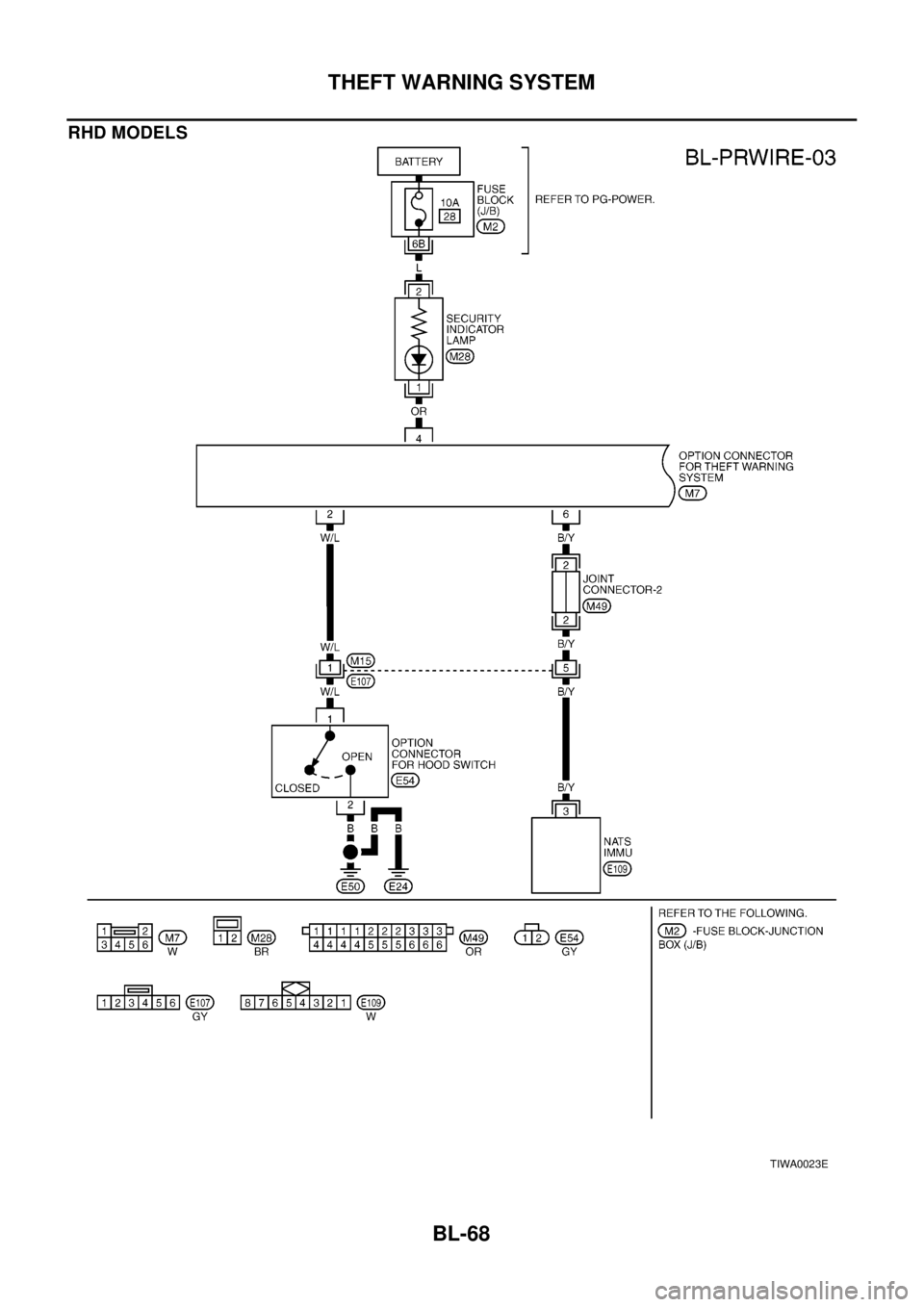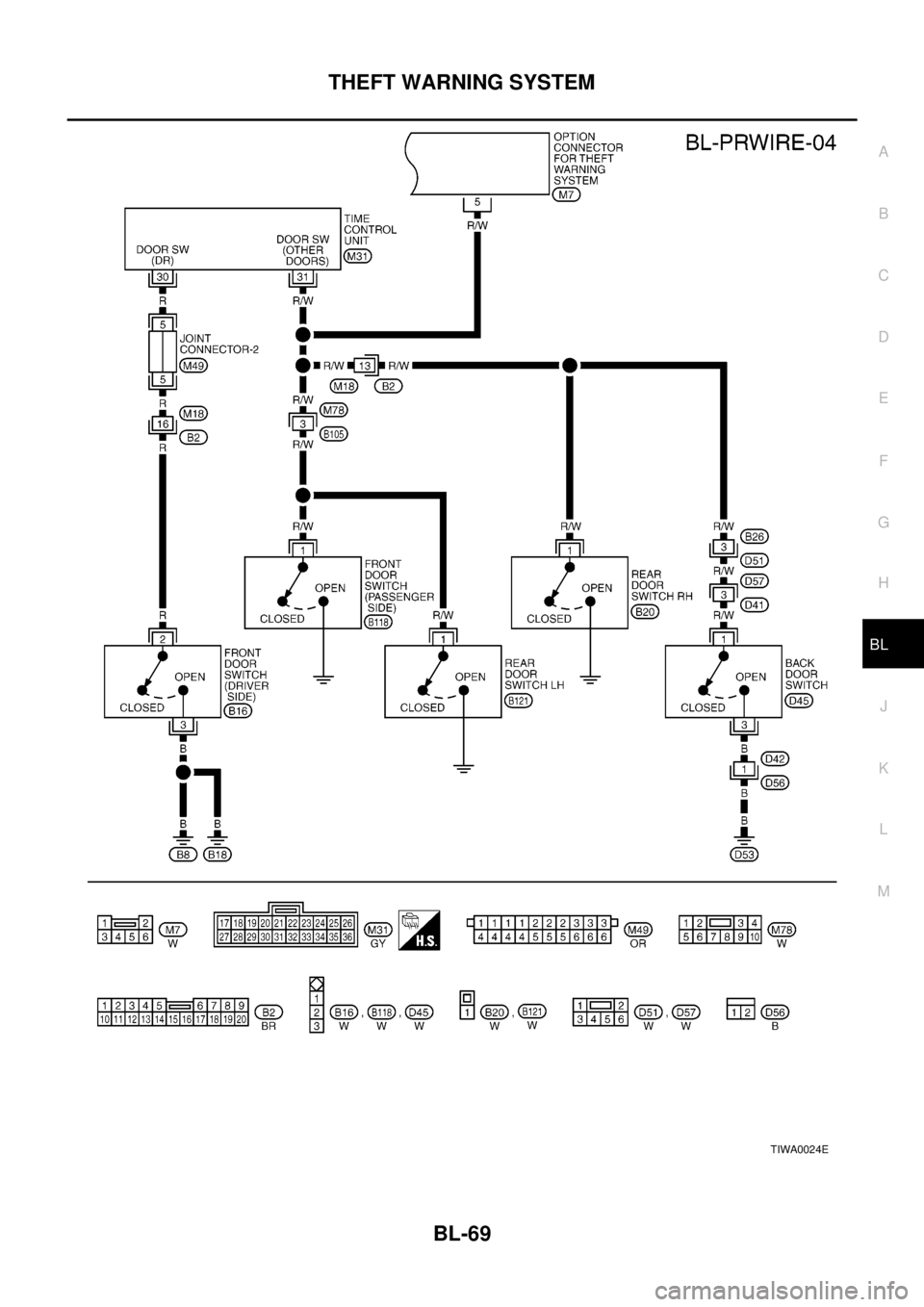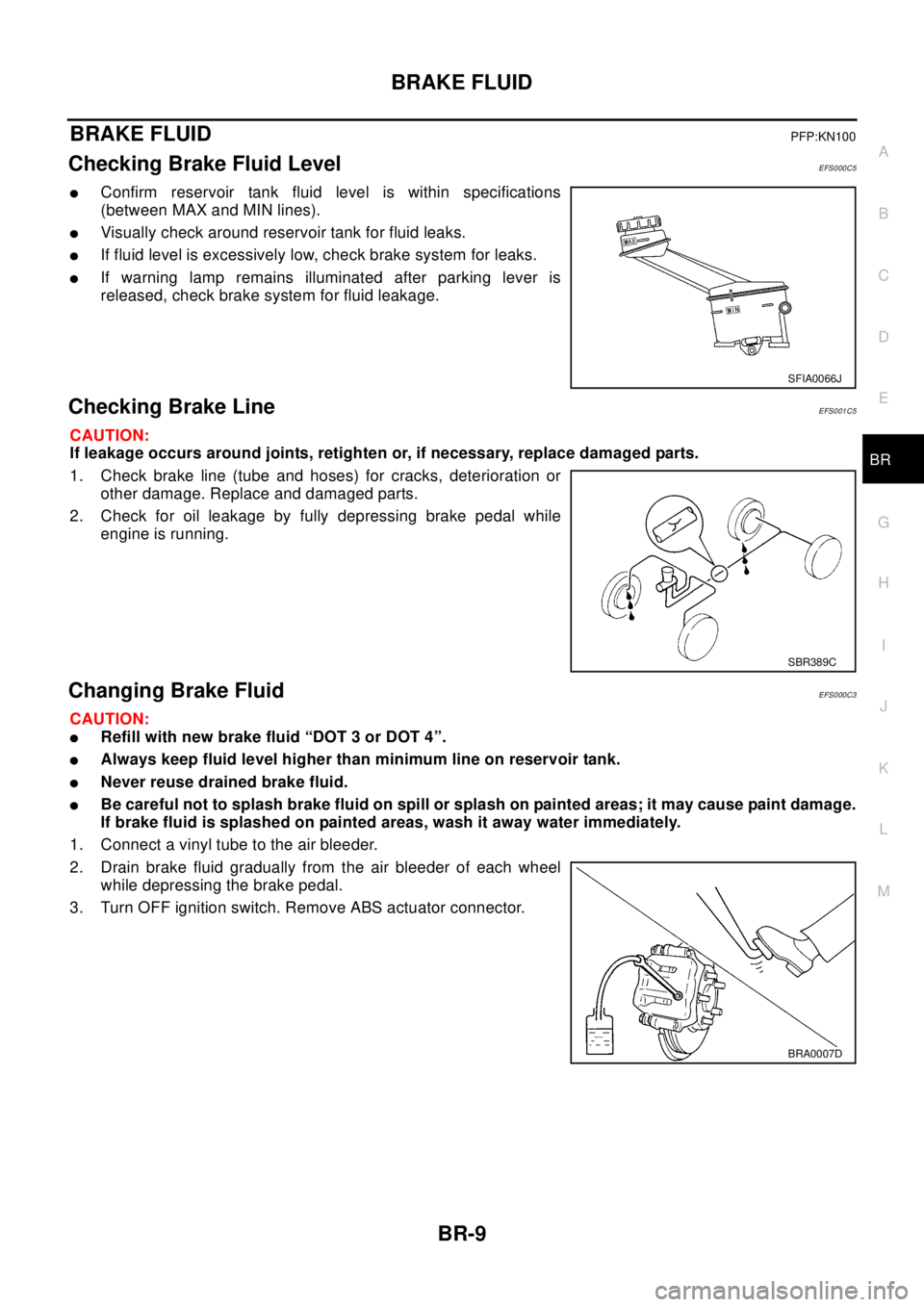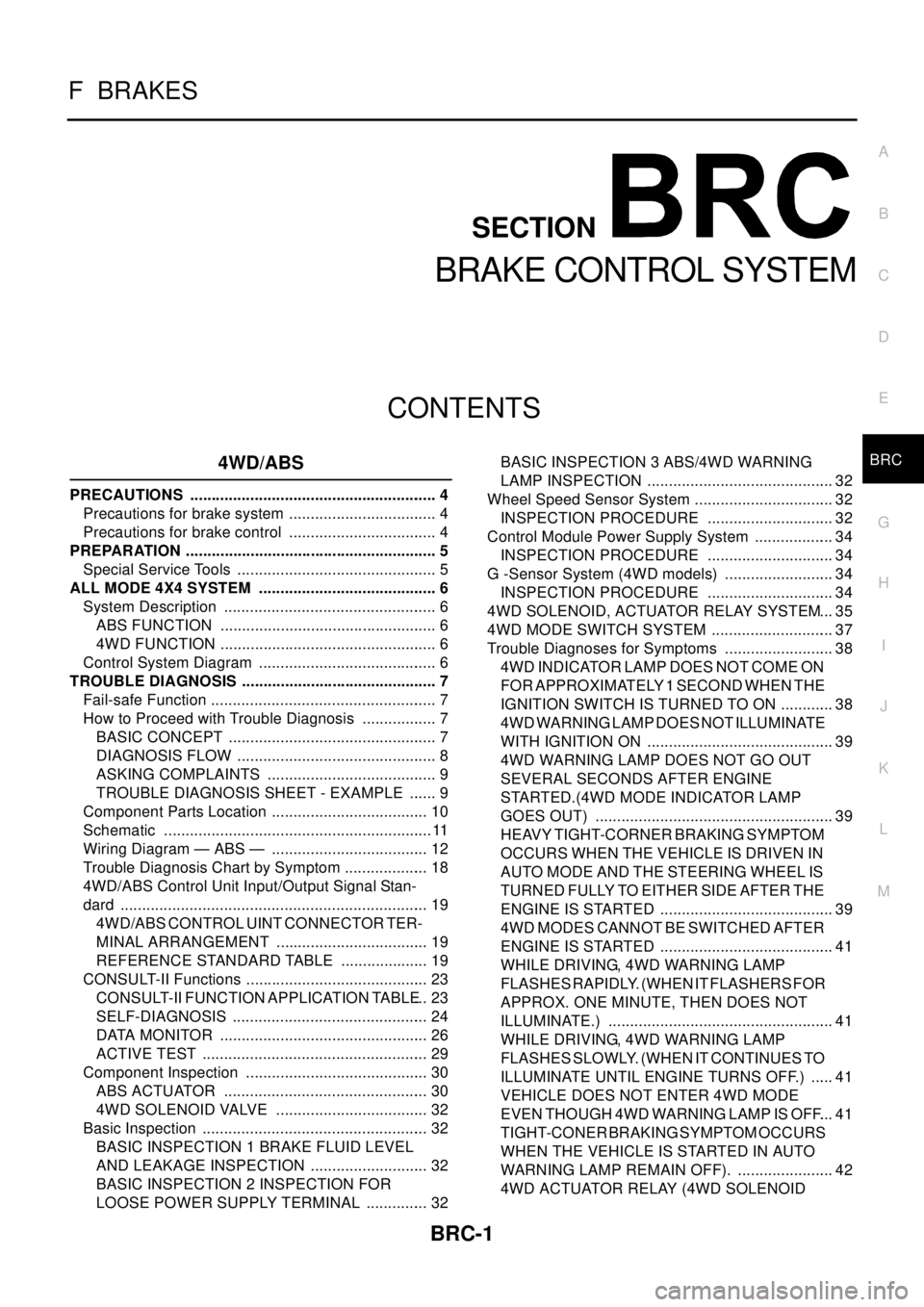2003 NISSAN X-TRAIL warning
[x] Cancel search: warningPage 812 of 3066

BL-68
THEFT WARNING SYSTEM
RHD MODELS
TIWA0023E
Page 813 of 3066

THEFT WARNING SYSTEM
BL-69
C
D
E
F
G
H
J
K
L
MA
B
BL
TIWA0024E
Page 843 of 3066

BRAKE FLUID
BR-9
C
D
E
G
H
I
J
K
L
MA
B
BR
BRAKE FLUIDPFP:KN100
Checking Brake Fluid LevelEFS000C5
lConfirm reservoir tank fluid level is within specifications
(between MAX and MIN lines).
lVisually check around reservoir tank for fluid leaks.
lIf fluid level is excessively low, check brake system for leaks.
lIf warning lamp remains illuminated after parking lever is
released, check brake system for fluid leakage.
Checking Brake LineEFS001C5
CAUTION:
If leakage occurs around joints, retighten or, if necessary, replace damaged parts.
1. Check brake line (tube and hoses) for cracks, deterioration or
other damage. Replace and damaged parts.
2. Check for oil leakage by fully depressing brake pedal while
engine is running.
Changing Brake FluidEFS000C3
CAUTION:
lRefill with new brake fluid “DOT 3 or DOT 4”.
lAlways keep fluid level higher than minimum line on reservoir tank.
lNever reuse drained brake fluid.
lBe careful not to splash brake fluid on spill or splash on painted areas; it may cause paint damage.
If brake fluid is splashed on painted areas, wash it away water immediately.
1. Connect a vinyl tube to the air bleeder.
2. Drain brake fluid gradually from the air bleeder of each wheel
while depressing the brake pedal.
3. Turn OFF ignition switch. Remove ABS actuator connector.
SFIA0066J
SBR389C
BRA0007D
Page 869 of 3066

BRC-1
BRAKE CONTROL SYSTEM
F BRAKES
CONTENTS
C
D
E
G
H
I
J
K
L
M
SECTION
A
B
BRC
BRAKE CONTROL SYSTEM
4WD/ABS
PRECAUTIONS .......................................................... 4
Precautions for brake system ................................... 4
Precautions for brake control ................................... 4
PREPARATION ........................................................... 5
Special Service Tools ............................................... 5
ALL MODE 4X4 SYSTEM .......................................... 6
System Description .................................................. 6
ABS FUNCTION ................................................... 6
4WD FUNCTION ................................................... 6
Control System Diagram .......................................... 6
TROUBLE DIAGNOSIS .............................................. 7
Fail-safe Function ..................................................... 7
How to Proceed with Trouble Diagnosis .................. 7
BASIC CONCEPT ................................................. 7
DIAGNOSIS FLOW ............................................... 8
ASKING COMPLAINTS ........................................ 9
TROUBLE DIAGNOSIS SHEET - EXAMPLE ....... 9
Component Parts Location ..................................... 10
Schematic ...............................................................11
Wiring Diagram — ABS — ..................................... 12
Trouble Diagnosis Chart by Symptom .................... 18
4WD/ABS Control Unit Input/Output Signal Stan-
dard ........................................................................ 19
4WD/ABS CONTROL UINT CONNECTOR TER-
MINAL ARRANGEMENT .................................... 19
REFERENCE STANDARD TABLE ..................... 19
CONSULT-II Functions ........................................... 23
CONSULT-II FUNCTION APPLICATION TABLE... 23
SELF-DIAGNOSIS .............................................. 24
DATA MONITOR ................................................. 26
ACTIVE TEST ..................................................... 29
Component Inspection ........................................... 30
ABS ACTUATOR ................................................ 30
4WD SOLENOID VALVE .................................... 32
Basic Inspection ..................................................... 32
BASIC INSPECTION 1 BRAKE FLUID LEVEL
AND LEAKAGE INSPECTION ............................ 32
BASIC INSPECTION 2 INSPECTION FOR
LOOSE POWER SUPPLY TERMINAL ............... 32BASIC INSPECTION 3 ABS/4WD WARNING
LAMP INSPECTION ............................................ 32
Wheel Speed Sensor System ................................. 32
INSPECTION PROCEDURE .............................. 32
Control Module Power Supply System ................... 34
INSPECTION PROCEDURE .............................. 34
G -Sensor System (4WD models) .......................... 34
INSPECTION PROCEDURE .............................. 34
4WD SOLENOID, ACTUATOR RELAY SYSTEM... 35
4WD MODE SWITCH SYSTEM ............................. 37
Trouble Diagnoses for Symptoms .......................... 38
4WD INDICATOR LAMP DOES NOT COME ON
FORAPPROXIMATELY1SECONDWHENTHE
IGNITION SWITCH IS TURNED TO ON ............. 38
4WD WARNING LAMP DOES NOT ILLUMINATE
WITH IGNITION ON ............................................ 39
4WD WARNING LAMP DOES NOT GO OUT
SEVERAL SECONDS AFTER ENGINE
STARTED.(4WD MODE INDICATOR LAMP
GOES OUT) ........................................................ 39
HEAVY TIGHT-CORNER BRAKING SYMPTOM
OCCURS WHEN THE VEHICLE IS DRIVEN IN
AUTO MODE AND THE STEERING WHEEL IS
TURNED FULLY TO EITHER SIDE AFTER THE
ENGINE IS STARTED ......................................... 39
4WD MODES CANNOT BE SWITCHED AFTER
ENGINE IS STARTED ......................................... 41
WHILE DRIVING, 4WD WARNING LAMP
FLASHES RAPIDLY. (WHEN IT FLASHERSFOR
APPROX. ONE MINUTE, THEN DOES NOT
ILLUMINATE.) ..................................................... 41
WHILE DRIVING, 4WD WARNING LAMP
FLASHES SLOWLY. (WHEN IT CONTINUES TO
ILLUMINATE UNTIL ENGINE TURNS OFF.) ...... 41
VEHICLE DOES NOT ENTER 4WD MODE
EVEN THOUGH 4WD WARNING LAMP IS OFF.... 41
TIGHT-CONER BRAKING SYMPTOM OCCURS
WHEN THE VEHICLE IS STARTED IN AUTO
WARNING LAMP REMAIN OFF). ....................... 42
4WD ACTUATOR RELAY (4WD SOLENOID
Page 870 of 3066

BRC-2
ACTUATOR RELAY) TURNS ON/OFF FRE-
QUENTLY ............................................................ 42
ABS warning lamp does not illuminate. (ABS warn-
ing lamp does not come on when the ignition switch
is turned ON.) ......................................................... 42
ABS warning lamp illuminates with ignition ON, but
does not illuminates after a few seconds. (ABS
warning lamp has illuminated.) ............................... 42
4WD warning lamp does not illuminate with ignition
ON. ......................................................................... 43
4WD warning lamp does not go out several seconds
after engine is started. (Drive mode indicator lamp
goes out.) ................................................................ 43
Heavy tight-corner braking symptom occurs when
the vehicle is driven in AUTO mode and the steering
wheel is turned fully to either side after the engine
is started. ................................................................ 44
Drive modes cannot be switched after engine is
started. .................................................................... 45
Wheel driving, 4WD warning lamp flashes rapidly.
(When it flashes for Approx. one minute, then does
not illuminate.) ........................................................ 45
Wheel driving, 4WD warning lamp flashes slowly.
(When it continues to illuminate until engine turns
OFF.) ....................................................................... 45
Vehicle does not enter 4WD mode even though
4WD warning lamp is off. ........................................ 46
Tight-corner braking symptom occurs when the
vehicle is started in AUTO mode (4WD warning lamp
remain OFF). .......................................................... 46
E-TS actuator relay (4WD solenoid actuator relay)
turns ON/OFF frequently. ........................................ 46
Inspection of drive mode change-over switch path... 47
WHEEL SENSORS ................................................... 48
Removal and Installation ........................................ 48
G-SENSOR (4WD MODEL ONLY) ............................ 49
Removal and Installation ........................................ 49
SENSOR ROTOR ...................................................... 50
Removal and Installation ........................................ 50
REMOVAL ........................................................... 50
INSTALLATION .................................................... 50
ACTUATOR ............................................................... 51
Removal and Installation ........................................ 51
REMOVAL ........................................................... 51
INSTALLATION .................................................... 51
ESP/TCS/ABS
PRECAUTIONS ......................................................... 52
Precautions for Supplemental Restraint System
(SRS) “AIR BAG” and “SEAT BELT PRE-TEN-
SIONER” ................................................................. 52
Precautions for Brake System ................................ 52
Precautions for Brake Control ................................ 52
Precautions for CAN System .................................. 53
FOR INSPECTION .............................................. 53
FOR HARNESS REPAIR .................................... 53ON-VEHICLE SERVICE ............................................54
Adjustment of Neutral Position of Steering Angle
Sensor .....................................................................54
GENERAL INFORMATION .......................................56
Fail-Safe ..................................................................56
ABS SYSTEM ......................................................56
ESP/TCS SYSTEM ..............................................56
Hydraulic Circuit ......................................................56
ABS Functions ........................................................56
TCS Functions ........................................................57
ESP Functions ........................................................57
System Diagram .....................................................58
CAN COMMUNICATION ...........................................59
System Description .................................................59
FOR M/T MODELS ..............................................59
TROUBLE DIAGNOSIS ............................................60
How to Perform Trouble Diagnoses for Quick and
Accurate Repair ......................................................60
INTRODUCTION .................................................60
WORK FLOW ......................................................61
ASKING COMPLAINTS .......................................62
EXAMPLE OF DIAGNOSIS SHEET ....................62
Component Parts and Harness Connector Location... 63
Schematic ...............................................................64
Wiring Diagram —ESP/TCS/ABS— .....................65
Control Unit Input/Output Signal Standard ..............71
STANDARDS USING A CIRCUIT TESTER AND
OSCILLOSCOPE .................................................71
STANDARDS WITH CONSULT-II ........................75
Functions of CONSULT-II .......................................77
CONSULT-II MAINLY FUNCTION APPLICA-
TION TO ESP/TCS/ABS ......................................77
SELF-DIAGNOSIS ...............................................78
DATA MONITOR ..................................................81
ACTIVE TEST ......................................................84
For Correct and Quick Diagnosis ............................88
PRECAUTIONS FOR TROUBLE DIAGNOSIS ... 88
Basic Inspection ......................................................89
PRELIMINARY CHECK 1: (BRAKE FLUID
LEVEL AND LEAK INSPECTION) .......................89
PRELIMINARY CHECK 2: (INSPECTION FOR
LOOSE POWER SUPPLY TERMINAL) ...............89
PRELIMINARY CHECK 3: (INSPECTION FOR
ABS WARNING LAMP, ESP OFF INDICATOR
LAMP, AND SLIP INDICATOR LAMP) .................89
Inspection 1 Wheel Speed Sensor and Circuit .......90
Inspection 2 Engine System ...................................92
Inspection 3 ESP/TCS/ABS Control Unit System ...92
Inspection 4 Pressure Sensor and the Circuit
between Pressure Sensor and ESP/TCS/ABS Con-
trol Unit. ...................................................................93
Inspection 5 Steering Angle Sensor and the Circuit
between Steering Angle Sensor and ESP/TCS/ABS
Control Unit. ............................................................94
Inspection 6 Yaw Rate Sensor/ Side G sensor and
the Circuit between Yaw Rate Sensor/ Side G sen-
sor and ESP/TCS/ABS Control Unit. ......................95
Inspection 7 Solenoid Valve, ESP Switch-over Sole-
Page 871 of 3066

BRC-3
C
D
E
G
H
I
J
K
L
MA
B
BRC noid Valve and Circuit ............................................ 97
Inspection 8 Actuator Motor, Motor Relay and Circuit
. 100
Inspection 9 Actuator Relay and Circuit ............... 102
Inspection 10 Stop Lamp Switch and Circuit ........ 104
Inspection 11 ESP/TCS/ABS Control Unit Power
Supply Circuit ....................................................... 104
Inspection 12 When “EMERGENCY BRAKE” is
indicated in the Self-Diagnosis Results ................ 106
Inspection 13 When “ST ANG SEN SIGNAL” is Indi-
cated in the Self-Diagnosis Results ..................... 106
Inspection 14 Brake Fluid Level of Reservoir Tank,
Communication Circuit between ESP/TCS/ABS
Control Unit and Brake Fluid Level Warning Switch. 107
Inspection 15 CAN Communication Circuit, ESP/
TCS/ABS Control Unit and Steering Angle Sensor. 108
Component Check ............................................... 109
ESP OFF SWITCH ............................................ 109
ESP/TCS/ABS RELAY BOX ............................. 109
ESP/TCS/ABS ACTUATOR ............................... 110
Symptom 1: ABS Works Frequently. ..................... 112
Symptom 2: Unexpected Pedal Action .................. 112
Symptom 3: Longer Stopping Distance ................. 113
Symptom 4: ABS Does Not Work. ........................ 114
Symptom 5: Pedal Vibration and Noise ................ 114
Symptom 6: ESP OFF Indicator Lamp Does Not Illu-minate ...................................................................115
Symptom 7: SLIP Indicator Lamp Does Not Illumi-
nate .......................................................................116
Symptom 8: During ESP/TCS/ABS Control, Vehicle
Behavior is Jerky. .................................................116
ESP/TCS/ABS CONTROL UNIT ............................118
Removal and Installation ......................................118
REMOVAL .........................................................118
INSTALLATION .................................................118
WHEEL SPEED SENSORS ....................................119
Removal and Installation ......................................119
SENSOR ROTOR ...................................................120
Removal and Installation ......................................120
REMOVAL .........................................................120
INSTALLATION .................................................120
ESP/TCS/ABS ACTUATOR AND RELAY BOX .....121
Removal and Installation ......................................121
YAW RATE/SIDE G SENSOR .................................122
Removal and Installation ......................................122
REMOVAL .........................................................122
INSTALLATION .................................................122
ESP OFF SWITCH ..................................................123
Removal and Installation ......................................123
REMOVAL .........................................................123
INSTALLATION .................................................123
Page 872 of 3066
![NISSAN X-TRAIL 2003 Electronic Repair Manual BRC-4
[4WD/ABS]
PRECAUTIONS
[4WD/ABS]PRECAUTIONSPFP:00001
Precautions for brake systemEFS001B6
lRecommended fluid is brake fluid “DOT 3 ”or “DOT 4”.
lNever reuse drained brake fluid.
lBe caref NISSAN X-TRAIL 2003 Electronic Repair Manual BRC-4
[4WD/ABS]
PRECAUTIONS
[4WD/ABS]PRECAUTIONSPFP:00001
Precautions for brake systemEFS001B6
lRecommended fluid is brake fluid “DOT 3 ”or “DOT 4”.
lNever reuse drained brake fluid.
lBe caref](/manual-img/5/57402/w960_57402-871.png)
BRC-4
[4WD/ABS]
PRECAUTIONS
[4WD/ABS]PRECAUTIONSPFP:00001
Precautions for brake systemEFS001B6
lRecommended fluid is brake fluid “DOT 3 ”or “DOT 4”.
lNever reuse drained brake fluid.
lBe careful not to splash brake fluid on painted areas.
lTo clean or wash all parts of master cylinder, disc brake caliper and wheel cylinder, use clean brake fluid.
lNever use mineral oils such as gasoline or kerosene. They will ruin rubber parts of the hydraulic system.
lUse flare nut wrench when removing and installing brake tube.
lAlways torque brake lines when installing.
lBurnish the brake contact surfaces after refinishing or replacing
drums or rotors, after replacing pads or linings, or if a soft pedal
occurs at very low mileage. Refer toBR-10, "
Brake Burnishing
Procedure".
lBefore working, turn OFF ignition switch. Disconnect connectors
for ABS actuator and control module or battery terminals.
WAR NIN G:
lClean brake pads and shoes with a waste cloth, then wipe
with a dust collector.
Precautions for brake controlEFS001B7
lIf malfunction is indicated by 4WD warning lamp and/or ABS warning lamp, collect necessary information
from customer (what symptoms are present under what conditions). Find out possible causes before start-
ing service. Besides electrical system inspection, check operation of ABS actuator.
lIf malfunction is detected, proceed to trouble diagnosis after checking tire pressure and tire wear.
lStopping distance or steering stability may be deteriorated by the following conditions. Tire size and type
are in improper combination. Brake pads are not Nissan genuine parts.
lFitting tires of different size on vehicle can be cause of longitudinal vibration. Always use tires of the same
size and brand. Exchange front and rear tires on the following conditions: Longitudinal vibration occurs in
vehicle with tires of the same size and brand. After replacement, perform trouble diagnosis. 1580|None
l4WD/ABS function may have a failure or error under following condition: There is radio, antenna, or
antenna lead-in wire (including wiring) near control module.
lIf aftermarket parts (e.g. Car stereo equipment, CD player) have been installed, check electrical har-
nesses for pinches, open, and improper wiring.
SBR686C
Page 874 of 3066
![NISSAN X-TRAIL 2003 Electronic Repair Manual BRC-6
[4WD/ABS]
ALL MODE 4X4 SYSTEM
ALL MODE 4X4 SYSTEM
PFP:47850
System DescriptionEFS001CJ
ABS FUNCTION
lDuring ABS operation, brake pedal lightly vibrates and its mechanical noise may be heard. Thi NISSAN X-TRAIL 2003 Electronic Repair Manual BRC-6
[4WD/ABS]
ALL MODE 4X4 SYSTEM
ALL MODE 4X4 SYSTEM
PFP:47850
System DescriptionEFS001CJ
ABS FUNCTION
lDuring ABS operation, brake pedal lightly vibrates and its mechanical noise may be heard. Thi](/manual-img/5/57402/w960_57402-873.png)
BRC-6
[4WD/ABS]
ALL MODE 4X4 SYSTEM
ALL MODE 4X4 SYSTEM
PFP:47850
System DescriptionEFS001CJ
ABS FUNCTION
lDuring ABS operation, brake pedal lightly vibrates and its mechanical noise may be heard. This is a nor-
mal condition.
lWhen starting engine, or just after starting vehicle, brake pedal may vibrate. Also motor operating noise
may be heard from engine compartment. This is a normal status of operation check.
lWhen vehicle drives on rough, gravel, or snowy (fresh deep snow) road, the following conditions occur.
Stopping distance may be longer than that of vehicles without ABS.
4WD FUNCTION
lElectronically controlled 4WD is controlled by the same control module as that for ABS (4WD/ABS control
unit). 4WD/ABS control unit controls both electronically-controlled 4WD and ABS, based on input signals
from several sensors.
lIf electrical system-related malfunction occurred in 4WD/ABS system, control unit illuminates the following
lamps: 4WD warning lamp and/or ABS warning lamp on meter control unit assembly. This notifies driver of
malfunction. At the same time, control unit indicates malfunctioning part detected by self-diagnosis with
flashing pattern of LED. Indication on electronic system diagnosis tester (CONSULT) corresponds to this
flashing pattern as shown below.
Control System DiagramEFS001CK
Self-diagnostic test mode Remarks
Result of self-diagnosis Conformable to 4WD/ABS
Data monitor Conformable to 4WD/ABS
Active testChecks ABS solenoid valve ON/OFF, ABS motor ON/OFF, 4WD sole-
noid
Control unit part No. 4WD/ABS control unit
SFIA0350E